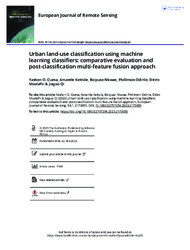| dc.contributor.author | Ouma, Yashon O | |
| dc.contributor.author | Keitsile, Amantle | |
| dc.contributor.author | Nkwae, Boipuso | |
| dc.contributor.author | Odirile, Phillimon | |
| dc.contributor.author | Moalafhi, Ditiro | |
| dc.contributor.author | Qi, Jiaguo | |
| dc.date.accessioned | 2023-08-07T10:40:58Z | |
| dc.date.available | 2023-08-07T10:40:58Z | |
| dc.date.issued | 2023-02-22 | |
| dc.identifier.citation | Ouma, Y. O., Keitsile, A., Nkwae, B., Odirile, P., Moalafhi, D., & Qi, J. (2023). Urban land-use classification using machine learning classifiers: comparative evaluation and post-classification multi-feature fusion approach. European Journal of Remote Sensing, 56(1), 2173659. | en_US |
| dc.identifier.issn | 22797254 | |
| dc.identifier.uri | 10.1080/22797254.2023.2173659 | |
| dc.identifier.uri | https://hdl.handle.net/13049/707 | |
| dc.description | This is an Open Access article distributed under the terms of the Creative Commons Attribution License (http://creativecommons.org/licenses/by/4.0/), which permits unrestricted use, distribution, and reproduction in any medium, provided the original work is properly cited. | en_US |
| dc.description.abstract | Accurate spatial-temporal mapping of urban land-use and land-cover (LULC) provides critical information for planning and management of urban environments. While several studies have investigated the significance of machine learning classifiers for urban land-use mapping, the determination of the optimal classifiers for the extraction of specific urban LULC classes in time and space is still a challenge especially for multitemporal and multisensor data sets. This study presents the results of urban LULC classification using decision tree-based classifiers comprising of gradient tree boosting (GTB), random forest (RF), in comparison with support vector machine (SVM) and multilayer perceptron neural networks (MLP-ANN). Using Landsat data from 1984 to 2020 at 5-year intervals for the Greater Gaborone Planning Area (GGPA) in Botswana, RF was the best classifier with overall average accuracy of 92.8%, MLP-ANN (91.2%), SVM (90.9%) and GTB (87.8%). To improve on the urban LULC mapping, the study presents a post-classification multiclass fusion of the best classifier results based on the principle of feature in-feature out (FEI-FEO) under mutual exclusivity boundary conditions. Through classifier ensemble, the FEI-FEO approach improved the overall LULC classification accuracy by more than 2% demonstrating the advantage of post-classification fusion in urban land-use mapping. | en_US |
| dc.language.iso | en | en_US |
| dc.publisher | Taylor and Francis Ltd. | en_US |
| dc.relation.ispartofseries | European Journal of Remote Sensing;56(1), 2173659 | |
| dc.subject | Gradient tree boosting | en_US |
| dc.subject | Multilayer perceptron neural networks | en_US |
| dc.subject | Post-classification feature fusion | en_US |
| dc.subject | Random forest | en_US |
| dc.subject | Support vector machine | en_US |
| dc.subject | Urban land-use land-cover | en_US |
| dc.title | Urban land-use classification using machine learning classifiers: comparative evaluation and post-classification multi-feature fusion approach. | en_US |
| dc.type | Article | en_US |

